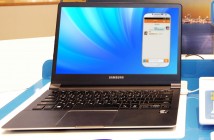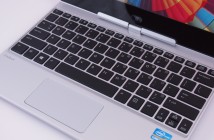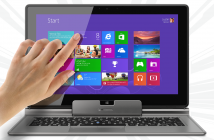
The Retina Display MacBook Pro is a culmination of all the best that Apple has to offer. It combines the hardware of MacBook Pro, the portability of MacBook Air, and the screen resolution of a new iPad; and yet it offers a little more extra with its new design. But is it really everything we had hoped for in a MacBook Pro?
Design
You might mistake it for a MacBook Air and with good reason too. Compared to the 15-inch MacBook Pro (2012) which remains virtually unchanged, it has a sleeker profile when viewed from different angles. It’s nearly as thin as the MacBook Air and only misses by 0.3 inches. Though not as light, it weighs a whole pound less than the 15-inch MacBook Pro which makes carrying it around less of a burden.
Technically speaking, it has the design DNA of its brothers so you shouldn’t be surprised to find a backlit keyboard, a speaker on each side, and the exact same trackpad. But this is not to say we don’t appreciate the changes Apple made on its dimensions. Unlike previous generation models or the standard 15-inch MacBook Pro (2012), I’m sure this won’t deter you from taking it anywhere with you.
Hardware and performance
We knew that a MacBook with Retina Display was coming all along but it exceeds our expectations by hundreds of pixels. It doesn’t just have the new iPad’s Retina Display – it has 2800 x 1800 pixels; a far cry from the 2048 x 1536 pixel resolution of the new iPad. Text is exceptionally crisp on the Retina Display MacBook Pro and pixels are impossible to tell apart with the naked eye. Colors are vivid, images have great depth and detail, and reading feels less straining on the eyes. A refined screen resolution has its pitfalls where it makes images and text appear small but this isn’t the case here. Apple managed to avoid them with a few software tweaks. Choosing to go with 16:9 aspect ratio was an odd move but doesn’t make that much of difference – unless you have strong preferences. Most screens have 16:10 displays but there was never a standard to begin with.
| 15-inch MacBook Pro (2011) | 15-inch MacBook Pro (2012) | 15-inch Retina Display MacBook Pro (2012) | |
|---|---|---|---|
| Dimensions | 14.35 x 9.82 x 0.95 in | 14.35 x 9.82 x 0.95 in | 14.13 x 9.73 x 0.71 in |
| Weight | 5.6 lbs | 5.6 lbs | 4.46 lbs |
| Display resolution | 1440 x 900 | 1440 x 900 | 2880 x 1800 |
| CPU | Up to 2.4GHz quad-core Core i7 (Sandy Bridge) | Up to 2.7GHz quad-core Core i7 (Ivy Bridge) | Up to 2.7GHz quad-core Core i7 (Ivy Bridge) |
| Graphics | Intel HD Graphics 3000 + AMD Radeon HD 6750M / AMD Radeon HD 6770M | Intel HD Graphics 4000 / NVIDIA Kepler GeForce GT 650M with up to 1GB of memory | Intel HD Graphics 4000 / NVIDIA Kepler GeForce GT 650M with up to 1GB of memory |
| Memory | Up to 8GB | Up to 8GB | Up to 16GB |
| Storage | Up to 750GB | Up to 1TB or 512GB SSD | Up to 768GB SSD |
| Ports | 2x USB 2.0, Thunderbolt, FireWire 800, SD card 3.0, Kensington lock slot, MagSafe power port, audio line in/out | USB 3.0, 2x Thunderbolt, FireWire 800, SD card slot, Kensington lock slot, MagSafe2 connector, audio line in/out | 2x USB 3.0, 2x Thunderbolt, SD card slot, HDMI, Kensington lock slot, MagSafe2 connector, headphone port |
| Battery life | 7 hours | 7 hours | 7 hours |
In term of processing and graphics, it reminds us of 15-inch gaming laptops we’ve come across with. They tend to have quad-core Core i7 Ivy Bridge and NVIDIA GPUs, making it no different from them. The Retina Display MacBook Pro comes with Ivy Bridge as a standard, except it’ll be offered in different speeds, ranging from 2.3 to 2.7GHz. We put it to the test and it felt like Origin EON 17-S. That being said, it can handle almost any task and multitask effortlessly. Benchmarks show it outperforms the 17-inch gaming laptop in multimedia multitasking, Adobe Photoshop CS5 image processing, and Apple iTunes encoding.
For graphics, the base model relies on Intel HD Graphics 4000 but you can choose to have NVIDIA GT 650M as a graphics processor – a huge leap from the AMD options offered in previous models. On average, graphic-intensive games like Call of Duty and Diablo 3 ran at 65 to 70 frames per second on the Retina Display MacBook compared to just 40-50 fps on older models powered by AMD’s GPUs. Results were drawn when playing in 1440 x 900 and 1680 x 1050 pixels which are currently their maximum supported resolutions. Once games start supporting 2800 x 1800 resolutions, frame could drop to 60 fps.
The Retina Display MacBook Pro has all the standard ports of the 2011 model. It still has Ethernet and FireWire but instead of two USB 2.0 ports, both were replaced by 3.0 which offer ten times speedier transfer rates. I can’t say you won’t like the Thunderbolt ports but you probably won’t have use for them unless you buy external drives that support the interface. A good example would be G-RAID with Thunderbolt. The new HDMI port is a great addition though since we’ve waited for years on end to have it on MacBook Pro. Now that it’s here, you can finally port content to compatible devices including HD TVs, projectors, external monitors, and the like. Even so, it still lacks an internal optical drive for reading and writing Blu-ray DVDs. Well at least Apple was thoughtful enough to include support for it with an optical drive slot.
By default, it has a 256 GB solid state drive for storage but you can upgrade it to 768GB – a slight upgrade from last year. The 8GB limit on memory was lifted, giving users the option to upgrade it to 16GB instead.
Battery life
More than often, high-resolution screens have high demands on processing power. In turn, it drains the battery of a device much faster than those with lower display resolutions. Instead, Apple touts it to have the same 7-hour battery life as the 15-inch MacBook Pro from last year. When placed on continuous video playback, it lasts up to 419 minutes – a shy 5-minute advantage over the 2011 MacBook Pro. That’s an impressive battery life considering it has a more powerful processor and twice the number of pixels.
Verdict
The 15-inch MacBook Pro with Retina Display is more of a luxury than a commodity, at least, from the viewpoint of average users. The least expensive model sells for $2,199 which is an expensive price to pay for all-around use. When seen from the eyes of professionals who deal with media like photos, art, and videos, it’s a must-have. But if you already have the 2011 MacBook Pro and supplemental Thunderbolt storage, perhaps you should wait next year when Apple decides to include an internal optical drive.



